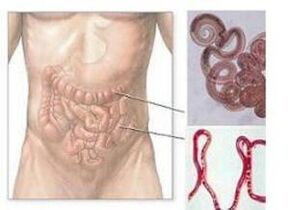Parasites are living creatures whose existence is directly related to their host. In other words: Parasitic organisms live at the expense of the host, exploiting it for their own interests and at the same time influencing it negatively. These creatures are extremely hardy and multiply quickly, making fighting them quite a difficult task. This type of living beings include: viruses, bacteria, fungi and protozoa. In particularly severe cases, parasites deprive their owner of all juices, poison him with the products of their vital activity and seriously harm his health. How do you recognize parasites in the human body?
Who are parasites?

Parasites are organisms that exist solely thanks to the host organism and at the same time negatively affect it. These include various types of bacteria, fungi, protozoa and worms. Bacteria are the smallest in size. Nevertheless, they can be the causative agents of quite serious diseases, including:
- pest
- typhus
- tuberculosis
- tetanus
- meningitis etc.
Fungal parasites are the most developed organisms of this species. There are up to a hundred species of pathogenic fungi. They are slightly larger than bacteria and, in contrast to them, have excellent protection against environmental influences and are also equipped with good adaptability to changing environmental conditions. They are divided into two groups: filamentous fungi and yeast fungi. The most prominent representative of this type of parasite is the Candida fungus. They affect the skin, nails and mucous membranes of the host and are the causative agent of candidiasis.
The most popular parasites are helminths. This includes many species that live in different host systems. The trichine roundworm causes a disease called trichinosis. This disease can affect both humans and pigs. Tapeworms, which belong to the class of flatworms, are intestinal parasites. They live in the digestive system of the host organism and feed themselves at its expense.

Most often their hosts are vertebrates: people, cats, dogs, fish. Tapeworms have special suction cups that they use to attach themselves to the intestinal wall. They absorb nutrients throughout their bodies because their primitive structure has no digestive tract or sensory organs.
There are many tapeworms. The length of these parasites varies between a tenth of a centimeter and nine meters. The structure of their bodies is also diverse: they can either be a whole organism or consist of segments connected to each other in a chain. Flatworms are hermaphrodites - each representative of this species is simultaneously male and female.
An equally common type of parasitic roundworm is the nematode. The best known among them: roundworms, pinworms, trichinae. Unlike tapeworms, they have an oral cavity through which they feed on nutrients stolen from the host. Most often they are heterosexual, but just like tapeworms, among them there are hermaphrodites - organisms that have sexual characteristics of both sexes.
Parasites are organisms that live exclusively at the expense of the host. Unlike other organisms that live in symbiosis with the human body, they constantly damage it due to their vital activity. Parasites include: protozoa, bacteria, fungi, helminths.
Routes of infection by parasites
There are many ways parasites can enter the human body. The most important are:
- nutritionally– through contaminated food, water;
- Contact household– Infection occurs through contact with contaminated objects, family members, pets;
- transferable– Infection by insects that feed on blood;
- active– The parasite enters the human body upon contact with contaminated soil or while swimming in a pond.
Nutritional

Among the food-borne worms, those transmitted through meat products deserve special mention. Pork and beef tapeworms are the most dangerous. The beef tapeworm can live in the human body for up to ten years and reach a length of three to ten meters. The pork tapeworm, which has settled in the intestines and begins to multiply, infects the entire human body with the help of its cysticercus larvae.
In addition, the meat of some animals may be contaminated with trichinae. A few days after trichinae penetrate the human body, a serious illness develops there - trichinosis. It often ends in death. When buying meat, you should always pay attention to the seller. Since he is a person directly related to food, his duties include regular medical examinations and strict adherence to hygiene standards. Unfortunately, these days few people pay attention to why such sources of disease arise.
Freshwater fish is also a dangerous product from the point of view of helminth infection. For example, cyprinids can cause a disease such as opisthorchiasis. The eggs of this parasite enter the fish via river mollusks and have practically no effect on the fish itself - it only serves as a vector for the parasite.
Dried, smoked or dried fish poses a serious danger. For example, raw pike caviar can be infected with the broad spectrum worm. Diphyllobothriasis is a disease caused by this worm. The broadband worm can reach a length of up to ten meters and parasitize the small intestine for decades.
Contact and household
The most well-known worms spread this way are pinworms and roundworms. Violation of hygiene rules is the main cause of enterobiasis and ascariasis. A child infected with pinworms scratches his anus while sleeping because the female pinworm comes out to lay eggs, after which various household items and clothing become infected.
If the infection is not recognized quickly, all family members can contract the disease. Giardiasis can be transmitted by drinking contaminated water. This parasite can even survive in chlorinated water. Household items: toys, dishes can also serve as a source of infection for these parasites.
Transmissible route of infection
Filariasis is a type of helminthiasis that can be transmitted by certain species of mosquitoes found in tropical and subtropical climates. Malaria or yellow fever is a deadly disease that is also transmitted by mosquitoes. Filariae can live in the blood and lymph and cause various negative reactions in the host.
Active route of infection
In this case, the parasites infect a person through direct contact with contaminated water or soil. For example, hookworm is a parasite that can become infected by walking barefoot on contaminated soil.
There are many types of infection with parasites, of which there are four main types. In order to somehow protect yourself from infection, you must carefully follow the rules of personal hygiene and try not to eat suspicious foods, especially meat.
How to identify parasites in the body

The symptoms of an infection of the body with parasites can be very different. Parasites can be recognized by the following signs:
- constipation. Due to their size and large number, some types of worms can cause blockage of various body systems: the bile duct and the intestines. These blockages lead to a certain type of disease and, in particularly severe cases, require surgical intervention.
- Diarrhea. Parasites, which produce prostaglandin-like substances due to their vital activity, trigger frequent and loose stools in the host.
- Flatulence. Worms can often cause inflammation in the intestines throughout their lives. These inflammatory processes lead to excessive gas production, which leads to bloating.
- allergy. Damaged linings of the gastrointestinal tract can allow molecules of undigested food to enter the blood. In this case, the immune system comes into play and as a result of its reaction, numerous eosinophils, i. e. cells that cause inflammation, are released into the blood, which indicates an allergic reaction in the body.
- Bad skin. Many different skin diseases can be caused by organisms that parasitize the skin.
- Weight problems. Weight deviations from the norm, both up and down, can serve as a sign of the presence of parasites in the body. Weight loss occurs due to indigestion and loss of appetite. Some helminths lower blood sugar levels and cause the host to experience uncontrollable hunger, leading to obesity.
- Chronic fatigue. Weakness, flu-like conditions, apathy, poor concentration and memory are signs that often occur with poor nutrition. In the case of a helminth infection, the functionality of the digestive system and therefore the absorption of various nutrients is impaired, which leads to chronic fatigue.
- Inflammation of the respiratory tract. Some types of worms move throughout the human body, including the respiratory tract. In some cases, they disrupt the lungs and cause cough and fever. Roundworms can even cause illnesses such as pneumonia.
- nervousness. The human nervous system can be seriously damaged by contact with helminth waste products. Various nervous disorders are a sign of helminth poisoning in the body.
Identifying parasites in the human body is not easy. Although the signs of their presence in the body are quite obvious, they can still be misinterpreted and attributed to a completely different disease. Therefore, the best way to detect parasites in the body is to see a doctor and undergo the necessary tests.
Parasites are various organisms that live by parasitizing another living creature. Due to their vital activity, the host's viability decreases significantly. There are many ways to become infected with parasites; they literally surround a person. The symptoms of an infection are very diverse and if you suspect an infection with parasites, you should see a doctor and undergo an examination.























